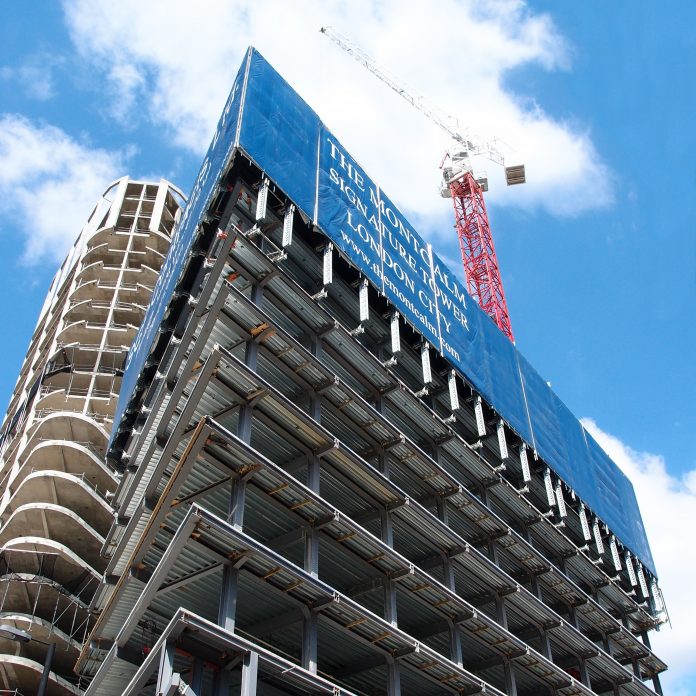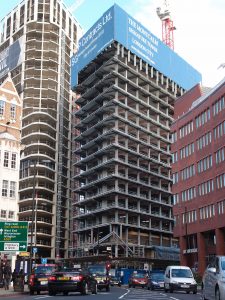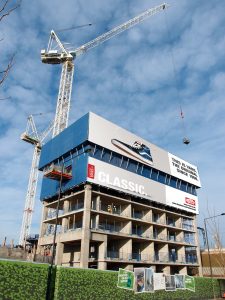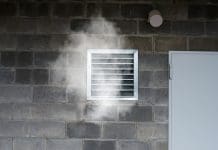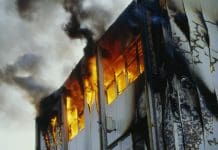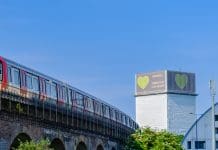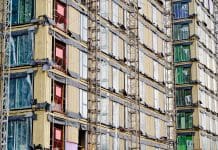Increasing urbanisation has led to a rise in the construction of high-rise and other tall commercial buildings, with more than four million high-rise buildings across the globe and another 3.5 million proposed. As a result, one area that needs urgently addressing is debris protection and the edge protection systems needed to ensure contractors and their employees, as well as the general public, stay safe and secure. Ian Fryer, divisional product innovation director at RMD Kwikform, discusses in more detail
Over recent decades, increasing urbanisation has led to an upturn in the construction of high-rise and other tall commercial buildings. The key economic driver for this trend is the lack of space in densely urbanised areas.
The rising population in cities has also meant that mixed-use buildings are gaining greater importance; high-rise construction is certainly no longer limited to just the financial and business sectors. As more than one million people around the world move to cities every single week, high-rise construction is now an accepted global model for managing the increasing number of city dwellers.
RMD Kwikform recently undertook a piece of research to better understand high-rise and commercial building construction methods, focusing on issues such as productivity, safety and the use of formwork and falsework systems. This surveyed leading contractors – both general and specialist – and engineering consultants to understand the areas where temporary works can have a significant impact on these projects, as well as identifying where there is a need for further education and insights.
Considering the wider context of increasing urbanisation, the growth in high-rise and tall commercial building projects and the findings of RMD Kwikform’s research, debris protection and on-site health and safety was identified as a top concern for contractors. Particularly with cast concrete construction, where concrete slabs extend beyond a building’s footprint, the opportunity for debris to fall over the edge is high unless the right edge protection systems have been installed.
As the skyline of the world’s cities become more and more spectacular, ensuring the right edge protection systems are in place will become even more important.
Making protection a priority
It should go without saying that health and safety should never be compromised in the construction industry. An M20 nut, for example, falling 12 floors will gain 50 joules of kinetic energy; over 14 joules is enough to fracture a human skull. It is, therefore, critical that adequate edge protection is specified.
Nevertheless, contractors are under incredible pressure to turn developments around quickly, on time and on budget. When the sheer scale of a project, tight timeframes and the number of subcontractors and teams that are involved in a development are all taken into account, it is clear how easy it can potentially be for health and safety risks to arise.
There are plenty of potential risks to consider. In inner-city areas with limited space, pedestrian walkways on the periphery of a site need to be protected from falling objects. On the ground, workers – who might be transporting goods from one point to another – must be kept safe from the building work that is taking place above them. On the other end of the spectrum, falls from height are the main causes of fatal accidents for those working in the construction industry in the EU. And then there’s the issue of ensuring neighbouring buildings are not damaged, or a contractor could be faced with a costly penalty and dispute.
In short, the construction industry has a duty to make the protection of people an absolute priority. Debris netting is often the typical solution specified to protect people from falling objects. Generally made from a durable, heavy-duty plastic netting, it helps catch falling materials, including dust, which can cause discomfort or eye injuries. For some projects, debris netting on its own will be sufficient. It generally provides safe containment of debris, while its versatility means it is easy and economical to handle.
However, for those seeking an assured debris protection solution, safety screens are a best practice approach for managing health and safety.
Specifying a safety screen system
Providing maximum debris sealing, a safety screen system delivers assured perimeter edge protection for site operatives, preventing falls from height, as well as sealing in construction debris and stopping objects from falling. Safety screen systems also accommodate various climates, with solutions available that can shelter workers from wind and rain, while providing ventilation too. This, ultimately, helps minimise downtime as well.
Other benefits include helping reduce vertigo for workers, further improving productivity levels too. Multi-level safety screens can also help significantly speed up working cycles for contractors.
There are a range of key considerations that contractors need to bear in mind when specifying a safety screen system. The available space will influence whether safety screens arrive preassembled or are assembled on site. The capabilities of on-site operatives may also dictate whether systems arrive ready-assembled.
Wind load is also an important consideration when erecting safety screens for tall buildings, and only becomes more critical as the height increases. Other considerations include crane usage, and heating and ventilation. For the former, having a system that can minimise or eliminate crane usage can considerably improve efficiency and productivity levels, as crane time is freed up for other works. For the latter, the environment and climate will often dictate the specified system. In warmer climates, a screen that provides adequate ventilation for workers is crucial. In contrast, for more volatile environments, the system must protect workers from the elements.
Location is also a key consideration when specifying a safety screen system, offering the potential for advertising. While plywood or corrugated steel cladding requires any marketing to be added to the systems separately, plastic screens can be printed with promotional messages in mind. This is a very popular option, as it can help provide the ultimate protection against the elements for workers, while also advertising brands and key marketing messages in prime locations in busy city centres. In fact, savvy contractors can even sell this advertising space to their client or another third party, with the capital raised going towards the cost of the safety screen system.
Overcoming traditional obstacles
Many of the latest safety screen solutions have been designed and developed to address the challenges associated with previous systems. In the past, screens could often not be lifted until the concrete slab had cured and the falsework had been struck. The screens would often not be big enough to cover two storeys, meaning column construction would stop just over one storey above the last cured level. This meant that column construction would have to be carried out above the protection of a screen, or workers had to wait until the screen could be lifted.
In contrast, many of today’s systems can be removed and lifted while the slab shoring is still in place. A lot of systems now also span two full storeys above the wet deck level, which enables work to be carried out on multiple levels at any one time. This ensures the slab and the columns above can also be cast. The safety screens can then be lifted up, with typically at least a metre of protection available. Both of these measures can help save critical time for contractors.
In the past, steel mesh was typically the only screen cladding option available. While this is effective, it does have its limitations too. Nowadays, safety screens come with a variety of cladding options, providing the contractor with the opportunity to select the best for the job. Steel mesh provides a fully rentable cladding option, for where multi-use is required.
Alternatively, plastic film cladding also offers a number of advantages, such as protection from the elements – particularly the wind. This option also offers contractors advertising opportunities, as branding and marketing messages can be printed onto it while it is on-site. Fire retardant nylon mesh screens also offer a very cost-effective alternative.
Another common problem in the past was that screens would often struggle to close corners or would not be well sealed between modules. There were also many instances where the gap between the lower slabs and the screen would not be sealed properly. Finally, many older safety screens could not be relied upon to provide sufficient edge protection, which meant independent systems had to be specified, adding to costs.
Today’s safety screen systems benefit from features such as rotating cladding beam ends and compression edge seals to help eliminate gaps. To seal lower slabs and the screen, plywood cladding flaps and flexible joint seals can help, and modern solutions are designed with perimeter edge protection as a top priority too.
The sky’s the limit
In conclusion, as the high-rise construction market shows no signs of letting up, contractors need to make sure that they have every confidence in the safety screens selected to help with debris protection. Not only do these prevent health and safety issues on-site, but they can also increase the speed and ease of erection, saving contractors valuable time and money.
The latest debris protection solutions offer features such as the capability to support multiple slab level access, enabling work to commence quickly and safely at levels below the wet decks, as well as multi-screen hydraulic climbing capabilities, which reduces the reliance on crane availability while improving operational efficiencies too. Supported by stronger masts, single depth profiles that can be more easily transported to site, and multiple screen cladding options that can accommodate increasingly complex building geometries, the latest edge protection solutions ensure contractors can feel confident that the systems meet the necessary health and safety standards for high-rise developments.
Ian Fryer
Divisional product innovation director
Twitter: @rmdkwikform
LinkedIn: RMD Kwikform


